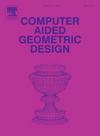随机曲线形状生成的离散高斯自由场方法
IF 1.7
4区 计算机科学
Q3 COMPUTER SCIENCE, SOFTWARE ENGINEERING
引用次数: 0
摘要
研究了一维离散高斯自由场(DGFF)和基于DGFF的二维固定端随机曲线采样方法,包括一种优先考虑形状变化且不需要现有数据的直接采样方法,以及一种数据驱动的扩散模型,用于从曲线形状的经验分布中采样。我们在形状优化问题中测试了所提出的方法,包括一个二维随机翼型形状采样问题,假设已知最小的物理知识。本文章由计算机程序翻译,如有差异,请以英文原文为准。
Discrete Gaussian free field methods for random curve shape generation
We study the one-dimensional discrete Gaussian free field (DGFF) and DGFF based methods for sampling random 2-dimensional curves with fixed ends, including a direct sampling method that prioritizes shape variety and does not require existing data, and a data-driven diffusion model for sampling from an empirical distribution of curve shapes. We test the proposed methods in shape optimization problems, including a 2-dimensional random airfoil shape sampling problem, assuming minimal physical knowledge is known.
求助全文
通过发布文献求助,成功后即可免费获取论文全文。
去求助
来源期刊

Computer Aided Geometric Design
工程技术-计算机:软件工程
CiteScore
3.50
自引率
13.30%
发文量
57
审稿时长
60 days
期刊介绍:
The journal Computer Aided Geometric Design is for researchers, scholars, and software developers dealing with mathematical and computational methods for the description of geometric objects as they arise in areas ranging from CAD/CAM to robotics and scientific visualization. The journal publishes original research papers, survey papers and with quick editorial decisions short communications of at most 3 pages. The primary objects of interest are curves, surfaces, and volumes such as splines (NURBS), meshes, subdivision surfaces as well as algorithms to generate, analyze, and manipulate them. This journal will report on new developments in CAGD and its applications, including but not restricted to the following:
-Mathematical and Geometric Foundations-
Curve, Surface, and Volume generation-
CAGD applications in Numerical Analysis, Computational Geometry, Computer Graphics, or Computer Vision-
Industrial, medical, and scientific applications.
The aim is to collect and disseminate information on computer aided design in one journal. To provide the user community with methods and algorithms for representing curves and surfaces. To illustrate computer aided geometric design by means of interesting applications. To combine curve and surface methods with computer graphics. To explain scientific phenomena by means of computer graphics. To concentrate on the interaction between theory and application. To expose unsolved problems of the practice. To develop new methods in computer aided geometry.
 求助内容:
求助内容: 应助结果提醒方式:
应助结果提醒方式:


